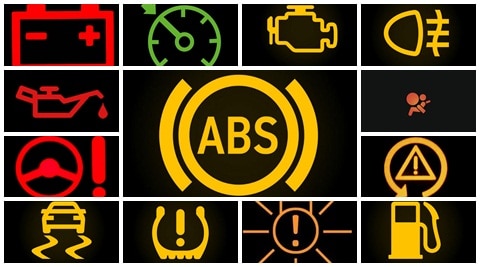Modern production cars are equipped with a host of warning and indication signals that are present on the instrument cluster. These provide the necessary information and warning signs about what can be wrong with the car. Some warnings can also prove to be fatal while others are a reminder of something critical and should be looked into. These are differentiated by different colours used for the warning or information lamps. A yellow or blue indication is to inform the driver, while a yellow warning lamp indicates a fault which needs to be looked into and read which involves the immediate assistance of the car by a professional. Here is a breakup of what each indication on an instrument cluster is, however, all the below mentioned features may not be available in the vehicle depending on its segment.
Blue or Green colour Indications – These denote merely information that a function in a car has been turned on such a high beam of a headlamp or cruise controls. In addition, features like turning indicator directions, DRL turning on and many other functions are a part of this category.
Yellow light indications
1. Low fuel warning – This indication tells you that the car is running on reserve fuel and a refill is required immediately. If you wait for this warning lamp to turn on every time for a refuel, in the long run, it would accumulate fuel dirt in your car eventually leading to a fuel tank replacement. Ideally when there are three bars left on the fuel gauge.
2. ABS – An ABS light turns on during a startup sequence of any car, however, if the indication remains on, it means there is a problem with the ABS sensor or the ABS system altogether. In the event of hard braking or panic braking, where ABS does not allow locking up of the wheels, would not work effectively or at all.
3. Bulb Failure – This light indicates that there is a problem with the car’s one or more bulb. This may include defunct headlamps which need to be replaced immediately. Cars with LED headlamps or sophisticated headlamp setups would entail such an issue in a very long time. This symbol can also light up if a factory fitted equipment is replaced with aftermarket components, for example, Daytime Running Lamps.
4. Rear Fog Lamp Indication – Simply indicates that the rear fog lamps have been turned on. This feature benefits commuters travelling behind the said vehicle and allows them to see the car from a distance, especially during bad weather conditions.
5. Tyre Pressure Monitoring System – The TPMS or Tyre Pressure Monitoring System has sensors that monitor each wheel of a car and indicate when there is low pressure in any one or more tyres. Refilling air immediately is recommended.
6. Traction Control Indication Lamp – This indicates that the vehicle is losing traction and the traction control system is adjusting the brake pressure on each wheel so that the driver can regain the control of the car. When the system is working, the light blinks repeatedly.
Red Coloured Indications – These are the most alarming indications on an instrument cluster. Any warning that turns on should not be taken lightly and the right steps should be taken
Battery Warning Lamp – A battery warning lamp comes up when the battery in the vehicle is not charging. This may happen due to a weak battery or a damaged alternator that charges the battery for consistent use. Get the battery checked for its capacity to hold charge and the alternator belt if it is damaged
Power Steering Warning Lamp – Most cars in India are now offered with power steering which helps in maneuvering the vehicle with ease. However, a power steering warning lamp indicates a faulty power steering unit. In a hydraulic setup, most common problem is low power steering fluid, however, in a completely electrically-assisted power steering, the problem may lie with electrical components and roadside assistance should be immediately informed.
Low Engine Pressure Warning Lamp – This indication tells about low engine oil level and prolonged use can lead to an engine seize. If this light comes up, immediately park on the shoulder of the road you are travelling on and turn off the engine. Let the engine cool down so that a mechanic can top off the oil. While at it, ask the mechanic to also look at the level of the coolant to avoid any overheating of the engine.
The thumb rule is that any indication denoted by green or blue is merely an information of a system engaging or disengaging. The yellow indications denote that there is a point of concern with a particular component in the car and the red coloured lights indicate that the problem occurred in a car is severe and needs immediate attention.
